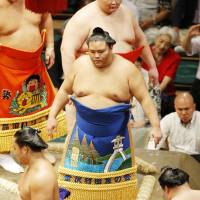Sumo wrestlers on overseas tours have been called 'naked goodwill ambassadors'.
Most people first encountering the sport see it as giant guys fighting while wearing almost nothing.
While it's true that there are no leotards or singlets in (professional) sumo, it's in fact one of the few grappling sports where there is something other than a body part to grab onto.
That something is of course the mawashi. There are two main types of mawashi worn by sumo wrestlers. The first — and by far the more common — is the rough canvas type that everyone in the makushita division and below (90% of all wrestlers) wears both in training and tournaments. Those are always black.
The same type of mawashi — but in white — is worn during practice by sekitori, wrestlers in the top two divisions. In tournaments, though, they wear a silk mawashi called a shimekomi.
A third type known as kesho mawashi, which is highly decorated, is worn by sekitori during the ring entrance ceremony.
Standard canvas mawashi material is about 45 cm wide and comes on a long roll. A length normally between five and six meters (depending on the girth of the wrestler) is cut off. To put it on, you straddle it then turn clockwise as it wraps around you like spaghetti on a fork. A second person is needed to tie the knot at the back.
Mawashi material is tightly woven, which makes it chafe and requires time to break in. Mawashi are also never washed. Instead they are unfurled and laid out in the sun after training. Walk past any sumo stable after training and you'll see mawashi on the street, hanging from the second floor or draped over fences.


















With your current subscription plan you can comment on stories. However, before writing your first comment, please create a display name in the Profile section of your subscriber account page.